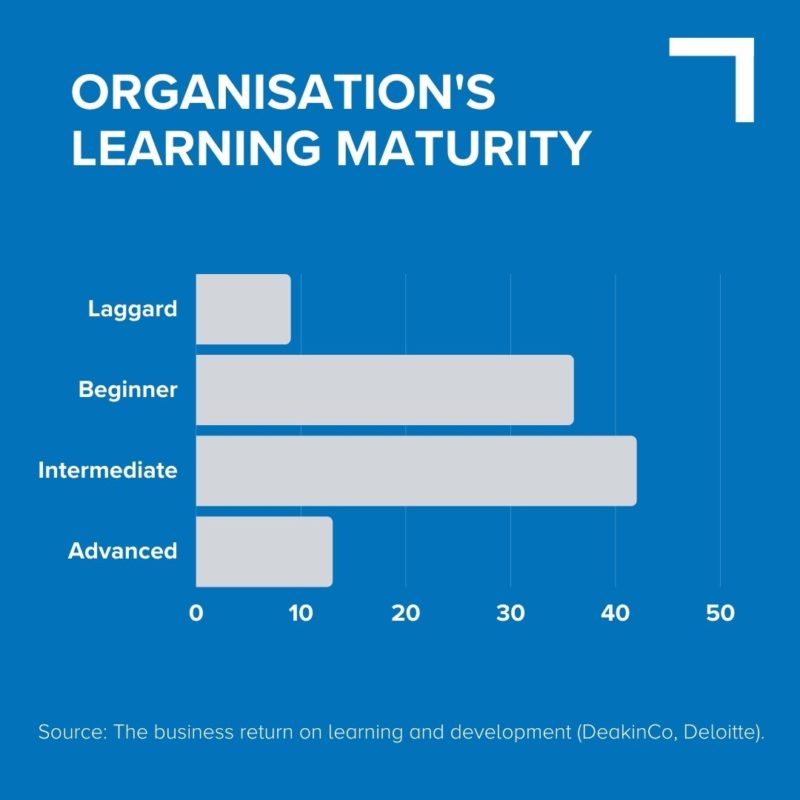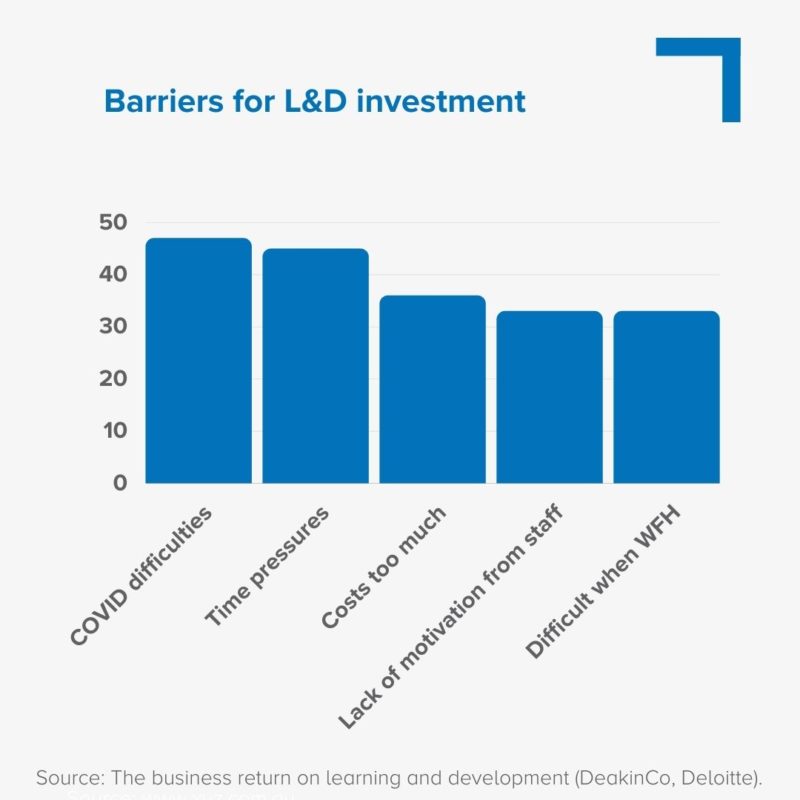For every $1 invested in learning and development per employee, business can expect a $4.70 return. But projected government cuts to skills funding could introduce barriers for employers.
Despite the billion-dollar cash injections into training and apprenticeships promised in last week’s budget, the Australian HR Institute has projected a less-than-desirable future for Australia’s skills investment.
Based on the latest government estimates, the recent cuts to vocational and industry training – which are largely due to the cessation of temporary COVID-19 support packages – could see the budget for learning and development drop from $4.95 billion in this financial year to $1.65 billion by 2025/26.
These cuts coincide with Australia’s lowest expected unemployment rate in 50 years, with forecasts suggesting it will sit at just 3.75 per cent by September.
While it might appear that low unemployment equals stronger productivity rates, that’s not quite the case. Productivity rates need to be driven by business growth, which requires employees with the right skills in the right jobs, and so any cuts to training budgets will make progress in this area an uphill battle.
“This potential dramatic cut in public spending for employer-led training could deliver a significant shock to employers looking to increase workplace productivity against a backdrop of rising skills shortages,” says AHRI’s CEO Sarah McCann-Bartlett.
These “damaging and large-scale” cuts could put Australia’s future at risk, she adds.
Gerwyn Davies, AHRI’s recently appointed Research and Advocacy Specialist adds that the withdrawal of funding comes at a time when employers’ training budgets are particularly vulnerable to rising cost pressures.
“The tightness of the labour market means that some employers will be looking to source labour from the hardest-to-reach groups, but may be reluctant to hire from these groups without government financial support,” says Davies.
Not got time to read the whole article? Here are some of the key takeaways:
-
- AHRI predicts Government spending on skills could drop by 67 per cent over the next four years.
- New research suggests a $1 investment in L&D generates a $4.70 return for business.
- Organisations that don’t forefront L&D have attrition rates 1.8 points higher than those that do.
- 51 per cent of businesses still need convincing of the benefits of investments in L&D.
Investments in learning and development pay businesses back in spades
Why should businesses be concerned about the projected drop in the Government training and skills budget? There are plenty of reasons.
For starters, new research from DeakinCo. and Deloitte Access Economics suggests that for every dollar invested into learning and development (L&D) per employee, businesses can expect a $4.70 return on investment.
“We know the more we invest in people, the more likely they are to stay with a business. Investing in reskilling and upskilling people improves their performance, morale and their willingness to go the extra mile,” says Glenn Campbell, Executive Director and CEO of DeakinCo.
“The dramatic cut in public spending for employer-led training could deliver a significant shock to employers looking to increase workplace productivity.” – Sarah McCann Bartlett, AHRI CEO
On top of this, the report found that organisations that forefront L&D saw attrition rates 11 per cent lower than businesses that don’t.
“We looked at the data and found that the more that organisations were investing in external learning and development that had a market value attached to it – so, something issued by a university – the more their staff wanted to stay.”
The survey respondents also stated that investments in L&D helped their businesses to ensure compliance with legal requirements (31 per cent), improve customer satisfaction (31 per cent) and facilitate internal promotions (29 per cent).
When you factor in the low unemployment and underemployment rates, as well as a slow return to international talent rates of pre-pandemic levels, Campbell says investment in upskilling has never been more important.
“All of these factors lead to one message: keep your staff because recruiting someone new is going to cost you a lot more money.”
Think beyond digital skills
The mention of a skills deficit often has people thinking of digital skills. While these are certainly important and worth investing in, zeroing in on these skills alone risks missing the bigger picture.
In their report, Deloitte and DeakinCo. found the top five sought after skills were, in order:
-
- Adaptability and flexibility
- Customer service
- Critical thinking and problem solving
- Data analysis
- Digital literacy
“The majority of them are human centred skills,” says Campbell. “And this is no different to what we found in previous research we did with Deloitte in 2017 and 2019.
“One of the challenges we have is that the typical media headlines talk about training around technology and that scares a lot of people. But if we actually look at the skills that enable us to adapt to new technology – from using an iPhone to artificial intelligence – they’re the same skills that assisted us in adapting to a pandemic; they’re all human centred.
“That’s what I would encourage people to focus on. If you’ve got a workforce that’s highly adaptable and flexible, [made up of] critical thinkers, and can solve problems and understand data… then you’re equipping people [to respond to] whatever technology change comes in the future.”
What’s holding businesses back?
Another interesting finding from the report is that 87 per cent of respondents felt their businesses could do more to improve L&D efforts, yet only 13 per cent were found to be leaders in this space.
Campbell said he was surprised by this gap. So what’s causing it?

Nearly 40 per cent of respondents cited costs as a barrier to investing in more training for employees, with time pressures and COVID-19 challenges cited as the main two reasons (see graph below for all responses).
In this instance, less Government funding could certainly place more financial pressure on organisations – laggard businesses currently invest an average of $1100 per employee versus the $3000 that advanced learning organisations spend, the report found.
However, Campbell suggests employers make use of the recent tax deduction announcements that came into effect on budget night. These stipulate that businesses with less than $50 million in annual turnover can claim 120 per cent of the costs of new technologies and training courses to upskill staff.

He also adds that being a top-tier learning organisation isn’t just about how much money you invest.
“There are a range of other factors, such as having a learning strategy, developing a learning culture, tracking and measuring returns on training and having tools to support training.”
DeakinCo. and Deloitte developed a ‘learning organisation framework’ to identify what are referred to as ‘advanced learning organisations’, i.e. businesses at the forefront of learning and development.
“While the spending element was part of it, we also asked questions around cost-effective measures, like coaching and mentoring. Those things contribute [to a learning culture]. But it’s not one or the other, it’s both.
“There’s an adage that the more you know, the more you realise you don’t know. And that holds true in this research. Advanced learning organisations were more likely to indicate that they needed to do more L&D with their staff than those at the laggard end.”
There was also a distinct difference between the types of training that organisations offered. Campbell says these can be broken into four categories: compliance training, technical training, human-centered skills training and leadership training.
“Laggard organisations were more likely to only invest in one of those. An advanced learning organisation was more likely to invest in all four areas.”
What should happen next?
In order to improve Australia’s approach to skills, Campbell says leaders, HR professionals and those with influence within a business need to start thinking about learning and development as an investment.
Interestingly, the report shows that 51 per cent of businesses need more convincing of the benefits of organisational training. While this is worrying, it presents HR professionals with an interesting challenge to shift perceptions by calling on their influence and presenting a data-backed business case.
“The way we look at a targeted marketing campaign through research and development – that’s how we need to look at L&D. Look at the business strategy and outcomes first and foremost.
“Executives are thinking about the best ways to invest their budgets to benefit the organisation. Now, if someone comes to them and says, “I want to invest in product development to advance our offering, become more competitive and increase sales.” And the next person just says, “I want to run X training program for staff.” Well, the first person came to them with an investment strategy, the second person didn’t. Think about the business imperative and how the training can make that happen.”
Campbell also suggests that businesses consider how they’re measuring and tracking the effectiveness of L&D.
“This was also one of the really interesting things that we saw between a laggard organisation and an advanced organisation,” he says. “The metrics they were using were fundamentally different.”
The report found that 56 per cent of businesses track their L&D success based on metrics obtained in employee satisfaction surveys, which Campbell says don’t really provide valuable information in this context. Only a third measured success against financial metrics, which is what Campbell suggests all businesses do moving forward.
AHRI is now calling on the Government to review its plan to cut public training budgets amid the current labour market, which is causing employers to clamber for the necessary skills to not only operate in the increasingly complex environments of today, but to thrive in the future.
“The review could also provide an opportunity to address some of the potential structural weaknesses of the Australian labour market,” says McCann Bartlett. “This applies especially to low-skilled workers, whose roles are particularly vulnerable to automation, and older workers who currently have a very limited training offering.”
How is your organisation responding to the skills shortage? Let us know in the comment section below.
AHRI offers a suite of learning and development opportunities, such as its certification program, the certificate IV in HR management, and a range of short courses across a variety of work-related topics.


Reinvestment and at least 70% guaranteed funding of TAFE would be a very significant antidote to this shortsighted approach by governments and employers.